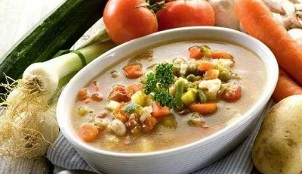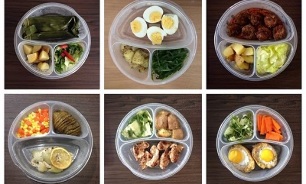
Inflammation of the stomach lining is uncomfortable and painful.
In addition to drug therapy, the diet for gastritis of the stomach is of great importance - the "right" products do not irritate the walls, contribute to the regeneration of the epithelium and maintain the remission of the disease.
What to eat for gastritis
There are many reasons for the development of gastritis:
- Incorrect diet, with predominance of dry, spicy and hot foods;
- Unbalanced diets;
- Abuse of alcoholic beverages, soft drinks;
- Taking certain medications that irritate the stomach lining
Before talking about what you can eat with gastritis and what you should refuse, you need to learn some basic postulates of the diet:
- Meals should be regular. You should not take long breaks between meals, miss lunch or afternoon tea for any reason and should not be replaced by a "double" dinner;
- For gastritis, fractional meals are shown - in small portions at short intervals;
- If possible, do not mix solid foods with liquids, the first dishes should be separated from the second. Liquid or mashed dishes are the easiest to digest;
- The temperature of the food must not be too high or low, hot food is absorbed optimally and does not irritate the stomach;
- The use of table salt should be minimized and spices should be completely abandoned;
- The diet should be rich in vitamins, but fibers for patients with gastritis are very heavy foods;
- Dishes are cooked, boiled (steamed) or stewed;
What you can eat with gastritis of the stomach
With high acidity
The purpose of the gastritis diet with increased hydrochloric acid secretion is to decrease acidity, neutralizing it with the help of stomach contents.
- Vegetable soups with pasta, rice. The vegetables are well boiled and blended;
- Milk soups with heavily boiled pasta or cereal;
- Yesterday's (dry) white bread made from wheat flour;
- Meat - lean beef, lamb and pork, chicken, turkey, skinless rabbit, tendons. The meat is roasted or steamed, chopped chops, soufflés, meatballs, beef stroganoff (cooked meat) are allowed;
- Milk and non-acid products - kefir, yogurt, cream, sour cream, cottage cheese (cheesecakes, casseroles), soft cheese varieties;
- Chicken, duck, quail eggs - cooked in soft paste or in the form of an omelet;
- Porridge: semolina, buckwheat, rice, oats, water or milk, viscous, wrapping, cereals must be boiled and sieved;
- Vegetables - cooked or boiled, mashed. Pumpkin, squash, potatoes, beets, carrots, cauliflower, tomatoes and green peas are rarely allowed;
- Fruits - neutral or sweet, bananas, peeled (roasted) sweet apples, pears, ripe persimmons. Berries - only sweets, in the form of jam, jams, fruit juices, marshmallows, marmalade, jam;
- As cold snacks, (with moderation! ) cooked tongue, liver pate, fish gelatin, red caviar, milk sausage and medical sausage, forshmak, unsalted ham are allowed;
- It is recommended to drink sweet jams, weak tea (with milk, cream), weak coffee with milk, cocoa, jam;
- Unsalted butter, ghee and refined vegetable oil are allowed.
Low acidity
When making a diagnosis, the goal is to stimulate the production of hydrochloric acid. Unlike the previous diet, in this case you can:
- Cook soups in fish and meat broths;
- Eat sour vegetables and fruits;
- Include salty and canned foods in the diet;
- Give preference to fermented dairy products;
- Drink acidic juices - orange, grapefruit, tomato, grape;
- Drink still mineral water
What not to eat with gastritis
With high acidity

- Soups cooked in broth and fish, mushroom soups, cabbage soup, borscht, okroshka;
- Fresh bread, pastry, pastry, puff pastry, rye bread and products made from rye flour;
- Fatty meat, poultry, smoked products derived from them;
- Fat and salty fish, canned fish;
- Sour milk products, spicy cheese;
- Fried and boiled eggs;
- Millet, barley, pearl barley, corn porridge;
- Pasta, except pasta;
- Vegetables, cabbage, rutabagas, turnips, sorrel, cucumber, spinach, onion; any vegetables in the form of pickles, preserved, preserved, canned; mushrooms;
- Sour fruits - melon, pomegranate, grape, peach, citrus, kiwi. Small berries seeds irritate the intestinal walls, so they are only consumed in processed form. Dried fruits are not recommended;
- Chocolate, ice cream;
- Sauces, mustard, pepper, horseradish. Limited to vanillin, cinnamon, dill, parsley, garlic;
- Nuts - peanuts, hazelnuts;
- Drink sodas, strong coffee, kvass bread.
Low acidity
Foods that cause fermentation in the stomach are prohibited:
- milk, cream, sour cream;
- confectionery, baked goods;
- chocolate;
- radish, garlic.
There is a controversial opinion on the use of watermelon: a ripe sweet watermelon does not hurt, but you should not abuse it, since the kidneys are overloaded, the risk of exacerbating urolithiasis increases.
Daily menu for gastritis
Despite strict prohibitions, healthy and tasty food is possible (and necessary! ), even during an exacerbation of gastritis. The recipes are varied, the main thing is to let your imagination run wild.
Example of the menu of the day:
- Breakfast. Buckwheat milk porridge (mashed), scrambled eggs, tea with milk;
- Second breakfast. Kissel, unleavened cookies;
- Lunch. Fish soup with vegetables (in the second broth), beetroot caviar, steamed chicken meatballs, tea with milk;
- Afternoon snack. Cottage cheese casserole with sour cream.
- Dinner. Vermicelli with fish cake, rosehip broth;
- Curdled milk for the night.

For gastritis with low acidity, the menu should be diversified with fruits, dairy products.
Strict adherence to the diet (table number 1) is necessary during the period of exacerbation and in the first two weeks after the attack is stopped.
Then you can gradually introduce additional foods into the diet, carefully monitoring your well-being.































